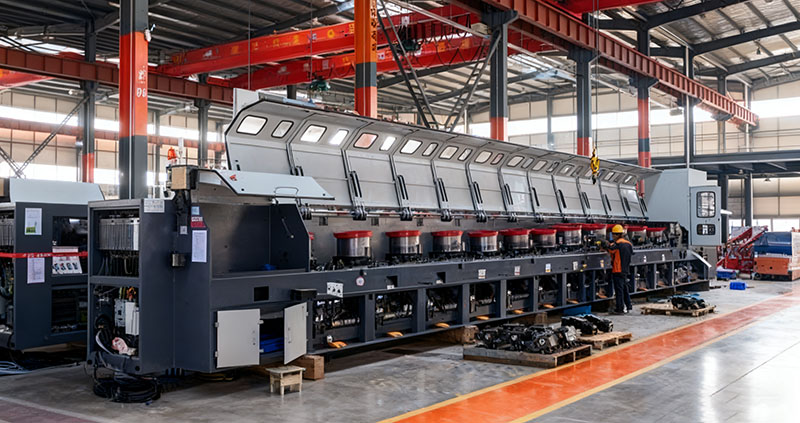Understanding the Working Principle of Wire Drawing Machines: How Metal Wires Achieve Precision "Slimming"

From small daily items like iron nails and copper wires in electrical cables, to large-scale applications such as steel wire ropes in construction machinery and special wires in the aerospace field—these metal wires of different shapes and properties all rely on the "shaping" of a key piece of equipment: the wire drawing machine. Simply put, the core function of a wire drawing machine is to "thin out" thick metal wires while making them tougher and more precise. Today, we will use plain language to break down the working logic, core components, and actual operation process of wire drawing machines, helping you understand the secrets of this industrial "transformation master".
1. Core Logic: Making Metal "Obedient" Through "Plastic Deformation"
The key to thinning thick metal wires lies in utilizing a special property of metals—plastic deformation. Just like when we roll dough into a thin strip, the dough changes shape under external force without breaking; when metal wires are subjected to sufficient tensile force, they also undergo "permanent deformation": their cross-sectional area decreases, their length increases, and they do not return to their original shape after deformation.
However, this "thinning" process follows two key principles:
Constant Volume: The product of "thickness × length" of the thick wire is equal to that of the thin wire. For example, when an iron wire with a diameter of 6mm is drawn into one with a diameter of 3mm, its length will become 4 times the original (since the cross-sectional area is proportional to the square of the diameter);
Avoiding Breakage: If the wire is thinned too much in one go, excessive local stress will easily cause it to break. Therefore, wire drawing machines use a "die cone angle" design, allowing the wire to undergo a "gradual transition" from thick to thin—similar to walking up a gentle slope for smooth deformation, ensuring uniform stress distribution.
During this process, the "crystal grains" inside the metal are also stretched and refined. Not only does the wire become thinner, but its strength and hardness are also significantly improved—for instance, a relatively soft iron wire becomes tougher after thinning, making it more suitable for making nails and wire meshes.
2. 6 Core Components: A "Transformation Team" with Clear Roles
A wire drawing machine is not a single device, but a "team" of multiple components working together. The most common type is the "continuous wire drawing machine". Taking it as an example, let’s look at the specific function of each component:
2.1 Pay-off Device: Stabilizing the "Raw Material" to Prevent Troubles
As the "starting point", the pay-off device is mainly responsible for fixing the "spool" (a component like a large thread reel) wrapped with thick wires, and then controlling the wire release speed and tightness through a "tension regulator". For example, when drawing steel wires, the tension needs to be adjusted higher to prevent the wires from loosening and tangling; when drawing soft wires like copper wires, the tension should be moderate to avoid breakage. Its core goal is simple: to ensure the thick wire enters the next process "steadily and smoothly".
2.2 Wire Drawing Die: The "Template" Determining Wire "Thickness"
The die is the "heart" of the wire drawing machine. The final thickness and precision of the wire depend entirely on it. The internal structure of the die has three key areas:
Different wires match different dies: "cemented carbide dies" are used for drawing iron wires and steel wires due to their wear resistance and durability; "diamond dies" are used for drawing copper wires or high-precision wires, as they have a smoother surface and can ensure wire precision. Moreover, the "cone angle" of the die is usually between 12° and 18°, which not only guarantees deformation efficiency but also prevents the wire from breaking midway.
2.3 Traction Device: The "Power Source" Providing "Tensile Force"
To make the wire pass through the die and deform, continuous tensile force is required—and this relies on the traction device. It mainly consists of "traction wheels" and a transmission mechanism. By making the traction wheels rotate faster than the pay-off wheels, a "speed difference" is generated, thereby applying axial tensile force to the wire. For example, when drawing a 6mm iron wire into a 3mm one, the rotation speed of the traction wheels must be precisely controlled—too fast and the wire may break, too slow and it won’t stretch. Most modern wire drawing machines use "frequency conversion speed regulation" to accurately control the rotation speed and avoid tension fluctuations.
2.4 Cooling and Lubrication System: "Cooling and Reducing Friction" for the Wire
During wire drawing, friction inside the metal generates heat. Excessively high temperatures will soften the wire and affect its strength; at the same time, friction between the wire and the die will wear out the die. This is where the cooling and lubrication system comes into play: it continuously sprays "wire drawing oil" (or emulsion) to achieve three effects:
Different industries use different oils: Hardware factories use "high-viscosity wire drawing oil" for drawing iron wires due to its strong wear resistance; Wire and cable factories use "low-viscosity wire drawing oil" for drawing copper wires to avoid oil contamination affecting the subsequent insulation layer wrapping.
2.5 Precision Detection and Control: The "Intelligent Eye" Guarding the "Quality Gate"
To ensure every wire meets the requirements, "real-time monitoring" is essential. The "laser diameter gauge" on the wire drawing machine constantly measures the wire diameter. Once it exceeds the allowable deviation (usually ±0.02mm, thinner than a human hair), the system will immediately sound an alarm and shut down. At the same time, the "tension control system" adjusts the tightness of pay-off, drawing, and take-up in real time to prevent the wire from tangling due to being too loose or breaking due to being too tight. Modern high-end wire drawing machines can also store process parameters, which can be directly used in the next production to reduce manual adjustment time.
2.6 Take-up Device: "Neatly Packaging" the Finished Product
As the "end point", the take-up device wraps the drawn finished wire neatly onto a new spool. Its rotation speed must be synchronized with the traction device to ensure uniform wire tension—if it rotates too slowly, the wire will pile up; if too fast, the wire will break. Some take-up devices are also equipped with a "wire arranging mechanism", which allows the wire to be distributed evenly like "winding yarn", facilitating subsequent transportation and processing (such as cutting into sections or electroplating for rust prevention).
3. Practical Operation Process: 6 Steps to Witness the "Slimming" of Iron Wire
Taking the common process in hardware factories—"drawing a 6mm iron wire into a 3mm iron wire"—let’s look at the complete working process of a wire drawing machine:
3.1 Prepare Raw Materials: Install the spool wrapped with 6mm thick iron wire on the pay-off stand. Check if there are scratches or rust on the iron wire surface. After confirming it is in good condition, pass one end of the iron wire through the tension regulator and adjust the tension properly.
3.2 Thread the Die and Position: Use the traction device to pull one end of the iron wire to the die, and pass it through the entry cone, working band, and exit cone in sequence. Ensure the iron wire is aligned with the center of the die—if it is misaligned, the drawn iron wire will become "elliptical" and fail to meet precision requirements.
3.3 Drawing and Forming: Start the traction device. The traction wheels rotate at the set speed and apply tensile force to the iron wire through the speed difference. When the iron wire passes through the working band with a 3mm hole diameter, its cross-section gradually shrinks from 6mm to 3mm, and its length increases simultaneously. The internal crystal grains are also refined, improving hardness and strength.
3.4 Cooling and Lubrication: During the drawing process, the cooling system continuously sprays wire drawing oil to cool the iron wire, lubricate the die, and flush away metal chips to ensure the iron wire surface is smooth.
3.5 Precision Detection: The laser diameter gauge monitors the iron wire diameter in real time. If the diameter is found to exceed 3.02mm or be less than 2.98mm, the system immediately alarms and shuts down. The operator checks if the die is worn or if the tension is stable, and restarts the machine after solving the problem.
3.6 Take-up and Storage: The qualified 3mm iron wire is wrapped onto a new spool by the take-up device. The wire arranging mechanism guides the even distribution of the iron wire. After the spool is fully wrapped, replace it with a new one to continue production. The wrapped iron wire can be directly sent for making nails, wire meshes, etc.
4. Multi-pass Drawing: The "Step-by-Step Slimming Method" for Ultra-fine Wires
If extremely fine wires need to be drawn (such as copper wires or steel wires with a diameter of less than 0.5mm), a single drawing process will result in excessive deformation, making the wire prone to breaking. In this case, "multi-pass drawing" is required—letting the wire pass through multiple dies with gradually decreasing hole diameters and deforming step by step.
For example, to draw a 5mm copper wire into an ultra-fine 0.3mm copper wire, 10-12 processes need to be set: the first die has a hole diameter of 4.5mm, the second 4.0mm, with each pass shrinking by 10%-15%, and the last die uses a 0.3mm hole diameter. Moreover, cooling, lubrication, and tension adjustment are needed after each process to ensure uniform and stable deformation at each step. This method not only avoids wire breakage but also ensures the final precision and surface quality. Most ultra-fine copper wires used in electronic devices are drawn in this way.
5. "Application Scenarios" and "Future Trends" of Wire Drawing Machines
5.1 Different Industries, Different Requirements
Wire drawing machines have a wide range of applications, and different industries have different requirements for them:
Medical Device Industry: Draws ultra-fine stainless steel wires and titanium alloy wires for making surgical instruments or implants. It has extremely high requirements for diameter precision (±0.001mm), surface smoothness, and biocompatibility, so high-precision diamond dies and clean wire drawing oil must be used.
5.2 The Future Will Be More "Intelligent, Efficient, and Environmentally Friendly"
With the development of industrial technology, wire drawing machines are constantly upgrading, mainly showing several trends:
![]() 中文
中文

